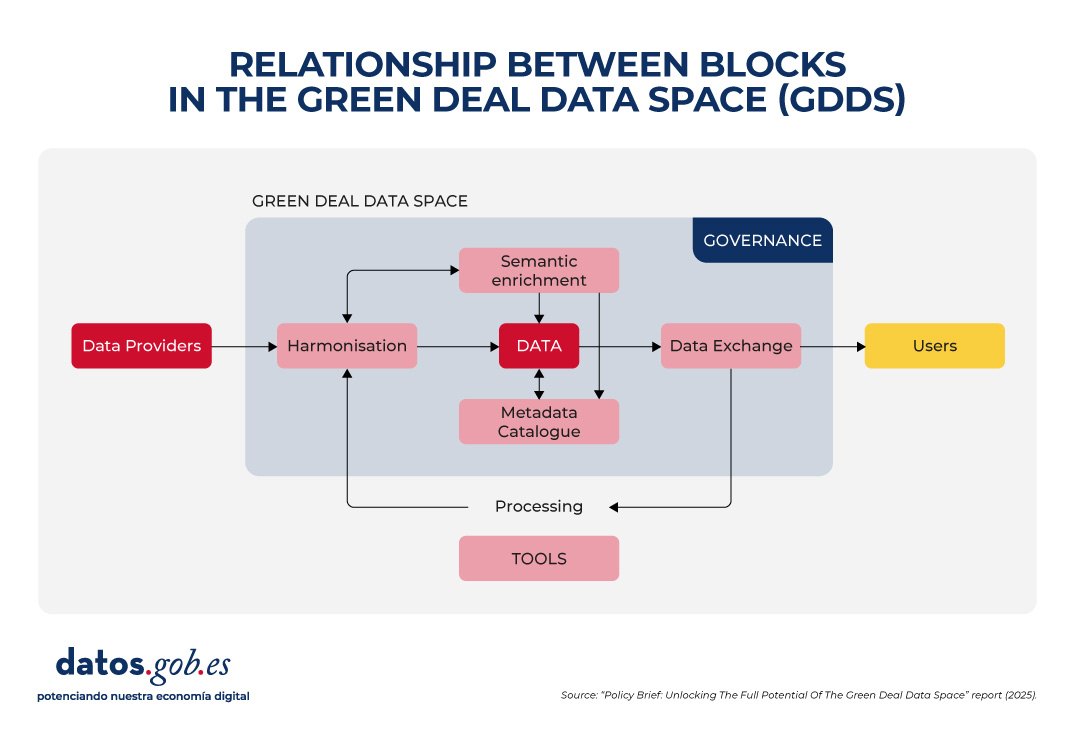
To achieve its environmental sustainability goals, Europe needs accurate, accessible and up-to-date information that enables evidence-based decision-making. The Green Deal Data Space (GDDS) will facilitate this transformation by integrating diverse data sources into a common, interoperable and open digital infrastructure.
In Europe, work is being done on its development through various projects, which have made it possible to obtain recommendations and good practices for its implementation. Discover them in this article!
What is the Green Deal Data Space?
The Green Deal Data Space (GDDS) is an initiative of the European Commission to create a digital ecosystem that brings together data from multiple sectors. It aims to support and accelerate the objectives of the Green Deal: the European Union's roadmap for a sustainable, climate-neutral and fair economy. The pillars of the Green Deal include:
- An energy transition that reduces emissions and improves efficiency.
- The promotion of the circular economy, promoting the recycling, reuse and repair of products to minimise waste.
- The promotion of more sustainable agricultural practices.
- Restoring nature and biodiversity, protecting natural habitats and reducing air, water and soil pollution.
- The guarantee of social justice, through a transition that makes it easier for no country or community to be left behind.
Through this comprehensive strategy, the EU aims to become the world's first competitive and resource-efficient economy, achieving net-zero greenhouse gas emissions by 2050. The Green Deal Data Space is positioned as a key tool to achieve these objectives. Integrated into the European Data Strategy, data spaces are digital environments that enable the reliable exchange of data, while maintaining sovereignty and ensuring trust and security under a set of mutually agreed rules.
In this specific case, the GDDS will integrate valuable data on biodiversity, zero pollution, circular economy, climate change, forest services, smart mobility and environmental compliance. This data will be easy to locate, interoperable, accessible and reusable under the FAIR (Findability, Accessibility, Interoperability, Reusability) principles.
The GDDS will be implemented through the SAGE (Dataspace for a Green and Sustainable Europe) project and will be based on the results of the GREAT (Governance of Responsible Innovation) initiative.
A report with recommendations for the GDDS
How we saw in a previous article, four pioneering projects are laying the foundations for this ecosystem: AD4GD, B-Cubed, FAIRiCUBE and USAGE. These projects, funded under the HORIZON call, have analysed and documented for several years the requirements necessary to ensure that the GDDS follows the FAIR principles. As a result of this work, the report "Policy Brief: Unlocking The Full Potential Of The Green Deal Data Space”. It is a set of recommendations that seek to serve as a guide to the successful implementation of the Green Deal Data Space.
The report highlights five major areas in which the challenges of GDDS construction are concentrated:
1. Data harmonization
Environmental data is heterogeneous, as it comes from different sources: satellites, sensors, weather stations, biodiversity registers, private companies, research institutes, etc. Each provider uses its own formats, scales, and methodologies. This causes incompatibilities that make it difficult to compare and combine data. To fix this, it is essential to:
- Adopt existing international standards and vocabularies, such as INSPIRE, that span multiple subject areas.
- Avoid proprietary formats, prioritizing those that are open and well documented.
- Invest in tools that allow data to be easily transformed from one format to another.
2. Semantic interoperability
Ensuring semantic interoperability is crucial so that data can be understood and reused across different contexts and disciplines, which is critical when sharing data between communities as diverse as those participating in the Green Deal objectives. In addition, the Data Act requires participants in data spaces to provide machine-readable descriptions of datasets, thus ensuring their location, access, and reuse. In addition, it requires that the vocabularies, taxonomies and lists of codes used be documented in a public and coherent manner. To achieve this, it is necessary to:
- Use linked data and metadata that offer clear and shared concepts, through vocabularies, ontologies and standards such as those developed by the OGC or ISO standards.
- Use existing standards to organize and describe data and only create new extensions when really necessary.
- Improve the already accepted international vocabularies, giving them more precision and taking advantage of the fact that they are already widely used by scientific communities.
3. Metadata and data curation
Data only reaches its maximum value if it is accompanied by clear metadata explaining its origin, quality, restrictions on use and access conditions. However, poor metadata management remains a major barrier. In many cases, metadata is non-existent, incomplete, or poorly structured, and is often lost when translated between non-interoperable standards. To improve this situation, it is necessary to:
- Extend existing metadata standards to include critical elements such as observations, measurements, source traceability, etc.
- Foster interoperability between metadata standards in use, through mapping and transformation tools that respond to both commercial and open data needs.
- Recognize and finance the creation and maintenance of metadata in European projects, incorporating the obligation to generate a standardized catalogue from the outset in data management plans.
4. Data Exchange and Federated Provisioning
The GDDS does not only seek to centralize all the information in a single repository, but also to allow multiple actors to share data in a federated and secure way. Therefore, it is necessary to strike a balance between open access and the protection of rights and privacy. This requires:
- Adopt and promote open and easy-to-use technologies that allow the integration between open and protected data, complying with the General Data Protection Regulation (GDPR).
- Ensure the integration of various APIs used by data providers and user communities, accompanied by clear demonstrators and guidelines. However, the use of standardized APIs needs to be promoted to facilitate a smoother implementation, such as OGC (Open Geospatial Consortium) APIs for geospatial assets.
- Offer clear specification and conversion tools to enable interoperability between APIs and data formats.
In parallel to the development of the Eclipse Dataspace Connectors (an open-source technology to facilitate the creation of data spaces), it is proposed to explore alternatives such as blockchain catalogs or digital certificates, following examples such as the FACTS (Federated Agile Collaborative Trusted System).
5. Inclusive and sustainable governance
The success of the GDDS will depend on establishing a robust governance framework that ensures transparency, participation, and long-term sustainability. It is not only about technical standards, but also about fair and representative rules. To make progress in this regard, it is key to:
- Use only European clouds to ensure data sovereignty, strengthen security and comply with EU regulations, something that is especially important in the face of today's global challenges.
- Integrating open platforms such as Copernicus, the European Data Portal and INSPIRE into the GDDS strengthens interoperability and facilitates access to public data. In this regard, it is necessary to design effective strategies to attract open data providers and prevent GDDS from becoming a commercial or restricted environment.
- Mandating data in publicly funded academic journals increases its visibility, and supporting standardization initiatives strengthens the visibility of data and ensures its long-term maintenance.
- Providing comprehensive training and promoting cross-use of harmonization tools prevents the creation of new data silos and improves cross-domain collaboration.
The following image summarizes the relationship between these blocks:

Conclusion
All these recommendations have an impact on a central idea: building a Green Deal Data Space that complies with the FAIR principles is not only a technical issue, but also a strategic and ethical one. It requires cross-sector collaboration, political commitment, investment in capacities, and inclusive governance that ensures equity and sustainability. If Europe succeeds in consolidating this digital ecosystem, it will be better prepared to meet environmental challenges with informed, transparent and common good-oriented decisions.


